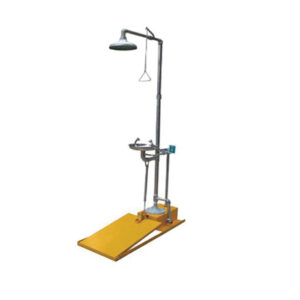Selecting the appropriate emergency safety shower for your workplace is crucial to ensure effective decontamination in the event of an emergency. With various types and configurations available, understanding the key factors to consider can help you make an informed decision. In this article, we will explore the different types of emergency safety shower and provide guidance on choosing the right one for your specific needs.
Types of Emergency Safety Showers
- Wall-Mounted Safety Showers: Wall-mounted safety showers are the most common type and are typically installed in indoor settings where space is limited. These showers are mounted directly onto the wall and feature a pull handle or push plate for activation.
- Free-Standing Safety Showers: Free-standing safety showers are ideal for outdoor environments or areas where wall mounting is not feasible. These showers are equipped with a sturdy base and can be placed at strategic locations for easy access.
- Combination Units: Combination units combine emergency safety showers with eye/face wash stations, providing comprehensive decontamination capabilities. These units are suitable for environments where the risk of eye exposure to hazardous materials is also a concern.
Considerations for Choosing an Emergency Safety Shower
- Flow Rate and Duration: Ensure that the emergency safety shower provides an adequate flow rate and duration to effectively rinse off hazardous substances from the body. Higher flow rates and longer durations facilitate thorough decontamination.
- Temperature Control: Opt for safety showers with temperature-controlled water to prevent further injury to the individual. Water that is too hot or too cold can exacerbate the effects of chemical exposure.
- Accessibility and Visibility: Choose safety showers that are easily accessible and clearly visible in the work area. Proper signage and lighting help ensure that individuals can quickly locate the shower during an emergency.
- Material Compatibility: Consider the types of hazardous materials present in your workplace and select safety showers constructed from materials that are compatible with those substances. This helps prevent corrosion or degradation of the shower equipment.
Installation and Maintenance Requirements
Once you have chosen the appropriate emergency safety shower for your workplace, proper installation and maintenance are essential to ensure its effectiveness during emergencies. Follow manufacturer guidelines for installation, and regularly inspect the shower for any signs of damage or malfunction. Conduct routine testing to verify that the shower activates correctly and delivers water at the required pressure and temperature.
Conclusion
Selecting the right emergency safety shower is crucial for ensuring the safety and well-being of workers in environments where hazardous materials are present. Consider factors such as flow rate, temperature control, accessibility, and material compatibility when choosing a safety shower for your workplace. By investing in the appropriate equipment and adhering to maintenance protocols, you can enhance emergency preparedness and minimize the risks associated with chemical exposure.


